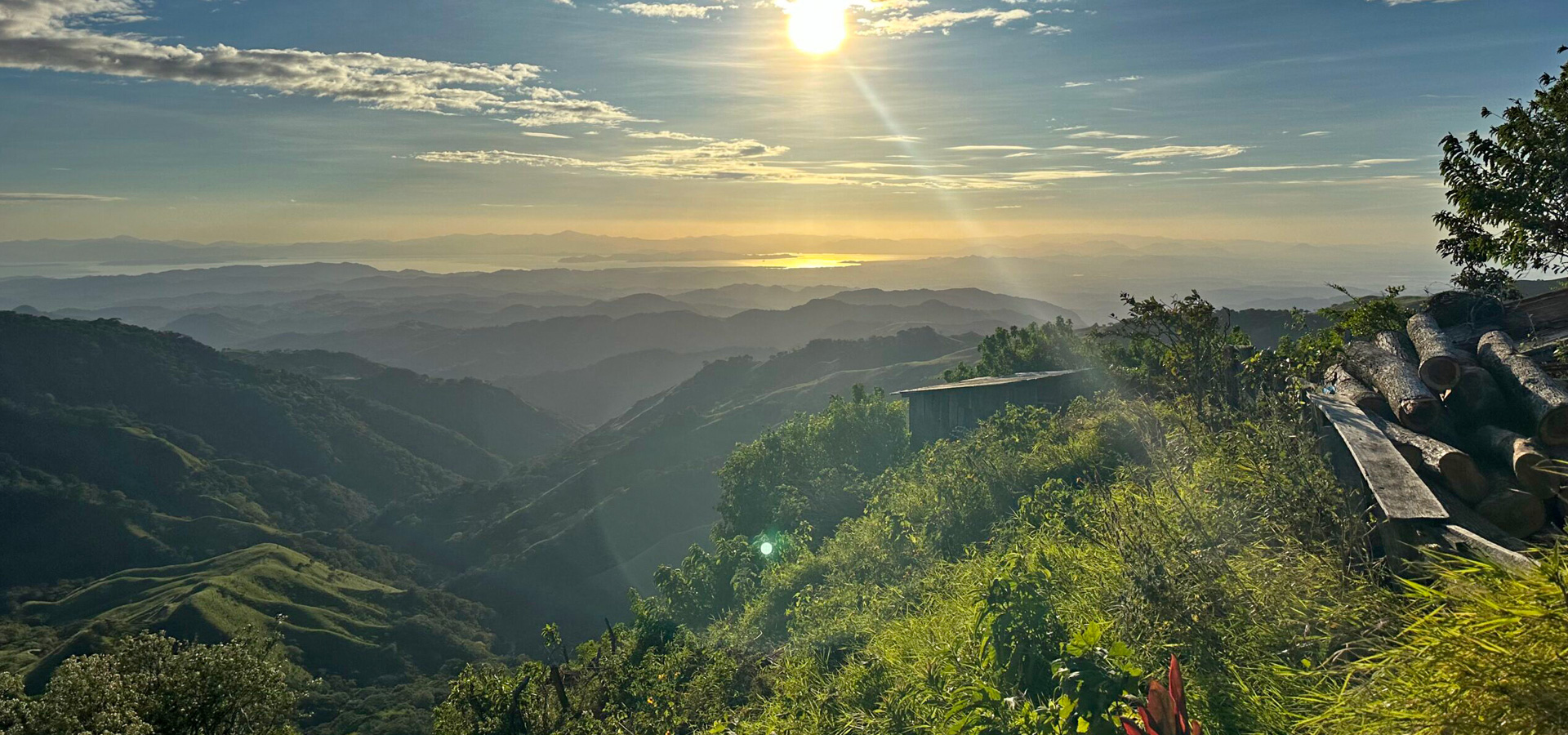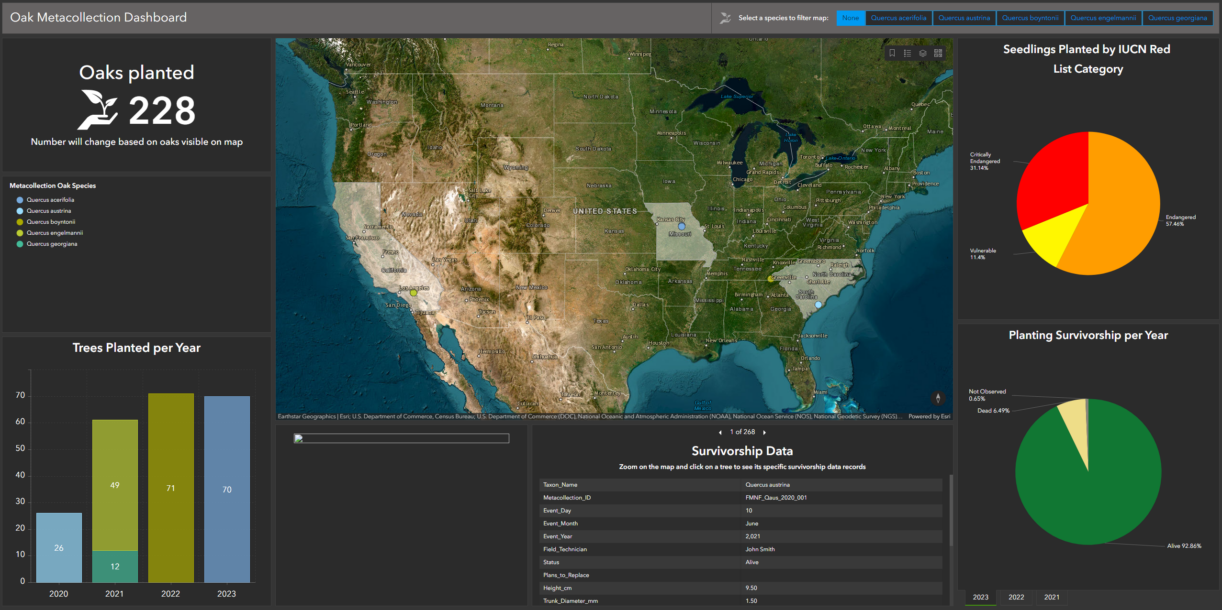The Morton Arboretum’s Global Tree Conservation Program (GTCP) works with a wide range of stakeholders to identify and implement needed conservation actions. Based on the research findings of the GTCP team and other scientists, the program works to mitigate threats affecting trees, enforce the protection of key habitats, and promote population recovery and ecological restoration.
Conservation action involves both policy and on-the-ground efforts, requiring the GTCP team to be trained in effective communication and problem solving as well as tree planting and physical work in the field. By partnering with conservation practitioners in academic research institutions, NGOs, and governmental agencies, the GTCP expands its reach to multiply the impact of actions taken for tree conservation.
With a special focus on oaks, the GTCP works in the world’s hot spots for oak biodiversity— the U.S., Mexico, Central America, China, and Southeast Asia.
In Situ Conservation Projects
The Global Tree Conservation Program participates in on-the-ground action projects with partners in the United States, Mexico, Guatemala, Costa Rica, Malaysia, Vietnam, Laos, and Indonesia.
These integrated conservation projects working with in-country partners respond to site-specific needs and improve the conservation, sustainable management, and recovery of tree species and ecosystems. The initiatives seek to benefit ecosystems while supporting local communities.
Conservation Action Plans
In collaboration with the Global Tree Assessment team and the International Union for Conservation of Nature (IUCN) Species Survival Species Survival Commission (SSC) Global Tree Specialist Group, The Morton Arboretum assessed the world’s oak species in 2020 and conducted conservation gap analyses for oaks.
Equipped with this information, staff at the Arboretum’s Center for Species Survival: Trees is working closely with the IUCN SSC Conservation Planning Specialist Group and the Global Conservation Consortium for Oak (GCCO) to lead and facilitate planning workshops with stakeholders to plan conservation and recovery actions for priority species through the development of conservation action plans.
Conservation action planning involves a group of stakeholders from various sectors and fields of expertise coming together to participate in an inclusive discussion and collaboratively develop a conservation action plan. This collaborative planning process establishes a foundation of trust and shared knowledge within the group, helping the group collectively achieve the goals laid out in the developed conservation action plan.
To guide the development of conservation action plans, the Global Tree Conservation Program follows the IUCN Conservation Planning Specialist Group’s Principles and Steps.
The information gathered at conservation action planning workshops results in the development of a conservation action plan for a given species that serves as a guiding document to inform stakeholders on the activities to take to effectively conserve the species over the next 5 to 10 years.
Species Steward Training Program
The Species Steward Training Program, developed by the Arboretum’s Center for Species Survival: Trees, and the Global Conservation Consortium for Oak aims to expand capacity in tree identification, propagation, restoration, and conservation, particularly in biodiversity hot spots where species loss is greatest.
Efforts to date are focused in Mexico and Central America, and are expanding into Southeast Asia.
Learn more about the Species Steward Training program >
IUCN Red List Assessments
In a rapidly changing world, it is crucial for conservationists, policymakers, and communities to have accurate, up-to-date information on the threats that face global plant diversity, since all life depends on plants. The International Union for Conservation of Nature (IUCN) Red List of Threatened Species is the globally recognized and standardized system for assessing the extinction risk of the world’s plant, animal, and fungal species.
Since 2015, The Morton Arboretum has worked in partnership with IUCN, the IUCN SSC Global Tree Specialist Group, and Botanic Gardens Conservation International (BGCI) to assess, review, contribute to, and facilitate IUCN Red List threat assessments for priority tree species globally. The Red Listing process is as follows:
- Research: Gather scientific literature on a tree species, consult with experts, determine the most serious threats, determine the species’ range size and attributes.
- Assess: Use the information generated by research to assess the species for threat status based on the categories and criteria set by IUCN.
- Review: Consult a species expert for review of the threat assessment.
- Submit: Submit the assessment to IUCN for approval.
- Publish: Publish all approved assessments on the IUCN website.
Working with Botanic Gardens to Conserve the Trees of the United States
The Arboretum’s Center for Species Survival: Trees is collaborating with botanical gardens across the United States and Mexico to ensure survival and sustainable management of threatened or at risk species of U.S. trees, particularly exceptional species that cannot be stored in seed banks, such as oaks, through the use of the One Plan Approach.
The One Plan Approach was developed by the International Union for the Conservation of Nature (IUCN)’s Conservation Planning Specialist Group. It calls for the development of management strategies and conservation actions by all responsible parties for all populations of a species, whether inside or outside their natural range.
At The Morton Arboretum, the Center for Species Survival: Trees supports the surveying, collection, propagation, and cultivation of U.S. trees of conservation concern underrepresented in ex situ collections, and promotes genetically diverse ex situ collections of high conservation value in botanic gardens.
Learn more about how the Arboretum works with botanic gardens to conserve U.S. trees >
Global Metacollection Dashboard
The Global Tree Conservation Program uses GIS mapping technology to allow anyone to visualize and interact with conservation planting sites as part of the Global Conservation Consortium for Oak’s (GCCO) metacollection project
A metacollection is the combined holdings of a group of collections for a particular species. For botanic gardens and arboreta, metacollections are envisioned as common resources held by separate institutions but stewarded collaboratively for research and conservation purposes.
Networking multiple collections into a single metacollection increases potential coverage within a species, allows broader access to greater diversity, dilutes risk of loss, and can reduce maintenance costs (Griffith et al., 2019).
The GCCO works with partners across the world to preserve threatened oak species in conservation plantings that help to form these larger metacollections. Several sites have already been established in the United States, with more to come as the network expands.
Explore the Global Metacollection Dashboard >
Metacollection Partnership Program
Oak acorns cannot be stored in seed banks for long-term conservation. To achieve one of its core objectives to conserve the genetic diversity of priority oak species, the Global Conservation Consortium for Oak (GCCO) coordinates living ex situ collections, known as metacollections, through its Metacollection Partnership Program.
Working with gardens, universities, NGOs, municipalities, government agencies, and Indigenous communities, is key to successfully meeting the GCCO’s objective of conserving genetic diversity of oak species.
The GCCO also works with partners with the capacity to host part of the permanent national oak metacollection such as the USDA Forest Service, tribal groups, and other managed public lands.
The GCCO’s Metacollection Partnership Program pairs these host site organizations with botanical garden partners who will collect and propagate the wild germplasm and work with the host site to design and plan a conservation grove. They also help plant, monitor, and maintain the grove over time as part of the national metacollection.
In addition to conserving valuable wild genetic diversity, the trees in the metacollections can be used for provenance testing, common garden experiments, genetic diversity studies, selective breeding, phenological studies, restoration and reforestation source material, public education and outreach, and other purposes.
Learn more about the Metacollection Partnership Program >

